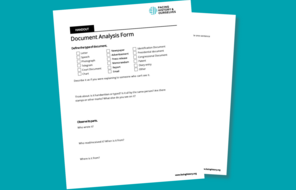
Document Analysis Form
At a Glance
Language
English — USSubject
- English & Language Arts
- History
- Social Studies
Grade
6–12Overview
What is Document Analysis?
Analyzing historical documents requires students to identify the purpose, message, and audience of a text. Document analysis forms are graphic organizers that guide students through a process of identifying important background information about a document (e.g., author/creator, date created, place, format, etc.) and using this data to determine the text’s bias or perspective.
Lesson Plans
How to Use a Document Analysis Form
Materials and Downloads
Quick Downloads
Download the Files
Get Files Via Google
Related Content
Unlimited Access to Learning. More Added Every Month.
Facing History & Ourselves is designed for educators who want to help students explore identity, think critically, grow emotionally, act ethically, and participate in civic life. It’s hard work, so we’ve developed some go-to professional learning opportunities to help you along the way.
Exploring ELA Text Selection with Julia Torres
On-Demand

Working for Justice, Equity and Civic Agency in Our Schools: A Conversation with Clint Smith
On-Demand

Centering Student Voices to Build Community and Agency
On-Demand















